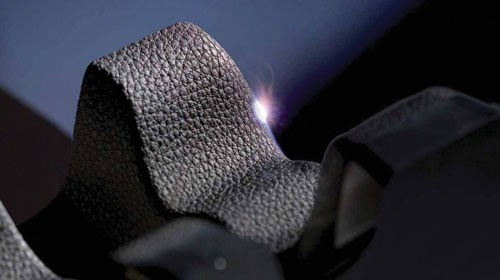Laser Ablation for Surface Texturing
How moldmakers can improve the level of control exerted in surface texturing.
In many industries, surface texture has become an important aspect of product design. It not only provides the means to refine the physical appearance of an item, but also allows a company to influence users’ tactile impression of their products. Command of this subtle interaction offers the opportunity to convey to customers a subconscious, and in some instances conscious, indication of product quality. It is of no surprise that moldmakers are increasingly seeking out ways to improve the level of control exerted in surface texturing.
Traditionally, one of two technologies has been employed to provide mold texturing. Moldmakers with 5-axis machining capabilities may use them for creating textures in addition to general machining. This can be an acceptable alternative if the shop has excess 5-axis capacity or only a relatively small percentage of jobs that require texturing. Otherwise, the opportunity costs quickly accumulate, as the equipment could be more productively used with roughing and finishing operations rather than with time-consuming texturing. Additionally, texturing in this manner requires very small, specialized tools, which increases the cost of the process.
Far more commonly, moldmakers turn to chemical etching. Compared to 5-axis machining, this method offers substantial time and cost savings. Unfortunately, it also requires sacrifices in the areas of consistency and quality, due to the impossibility of precisely controlling the texture produced. Chemical etching is also more than a little unfriendly to the environment, an issue of increasing importance for many manufacturers.
Recently, a new technology has emerged for surface texturing in the form of laser ablation. Already used in a variety of applications ranging from surgical procedures to production of superconductors, the process entails using a laser to sublimate material, or turn it directly from solid to gas. Laser ablation centers can be equipped with pulsed, fiber-optic lasers of varying strengths and use a variety of lenses with different focal lengths to maximize productivity. The process promises several key advantages to moldmakers requiring surface texturing.
1. Laser ablation offers far more precision and accuracy than can be achieved via chemical etching. No matter how much care is taken during etching, it is impossible to eliminate variation that results in a minimum of slight differences between workpieces. Laser ablation centers produce textures directly from digital files, allowing the creation of any number of identical components. Some manufacturers may think that variation is acceptable between components, but it becomes a much more apparent issue when thinking in terms of complex molds that require multiple inserts. In those instances, differences between the various inserts can result in a visibly inconsistent surface across the part. Laser ablation eliminates the need for this sacrifice in quality.
2. Laser ablation also has no environmental impact, another area where it far surpasses chemical etching. This provides substantial benefit even to those manufacturers unconcerned about the impact of their operations on the environment. Because of the nature of the chemicals used for etching, U.S. companies conducting it must comply with a host of regulations that substantially increase its price. As an alternative, parts can be shipped to companies doing business in countries with little or no environmental regulation, an option that brings with it substantial leadtimes and low flexibility in responding to urgent needs. In short, laser ablation will often be cheaper or faster than chemical etching, depending upon whether viewed in terms of domestic or international alternatives.
3. Laser ablation requires little manual labor. In addition to adherence to strict government regulations, chemical etching also requires substantial manual labor. Each part undergoing the process must be carefully prepared to ensure that the chemicals only access the features to be textured. Exposing other areas of the component to these chemicals can result in the entire piece being scrapped. Additionally, the process requires readying the chemicals, administering the bath, cleaning the part and disposing of the chemicals, all steps with high labor components. In contrast, laser ablation consumes very little labor. An operator sets the part in the machine, loads the program and walks away until the texturing is complete. While the actual process time of laser ablation will substantially exceed that of chemical etching, the ability to run fully unmanned minimizes labor utilization. The only true operating cost of the process is the cost of the electricity consumed.
4. Laser ablation opens the door for greater legal protection of innovative designs. The lack of repeatable results with chemical etching renders the process unable to create textures that could be submitted for patent protection. Laser ablation overcomes this hurdle, allowing moldmakers to create and protect surfaces that result in a truly unique appearance and feel in the final product.
With today’s high demands for product differentiation, laser ablation centers provide moldmakers with a new, unique means to meet and exceed their customers’ needs. By incorporating previously unattainable levels of quality and repeatability, a shop utilizing laser ablation will quickly stand out in the sea of competition.
Related Content
Breaking Down 3D Scanning in Moldmaking
Identifying 3D scanning requirements and implementing the appropriate technology.
Read MoreQuestions and Considerations Before Sending Your Mold Out for Service
Communication is essential for proper polishing, hot runner manifold cleaning, mold repair, laser engraving and laser welding services.
Read MoreFour Micro Tooling Considerations
Issues involving gating, ejection, mold splits and direction of pull are of special concern when it comes to micro tooling.
Read MoreRead Next
How to Use Continuing Education to Remain Competitive in Moldmaking
Continued training helps moldmakers make tooling decisions and properly use the latest cutting tool to efficiently machine high-quality molds.
Read MoreAre You a Moldmaker Considering 3D Printing? Consider the 3D Printing Workshop at NPE2024
Presentations will cover 3D printing for mold tooling, material innovation, product development, bridge production and full-scale, high-volume additive manufacturing.
Read MoreReasons to Use Fiber Lasers for Mold Cleaning
Fiber lasers offer a simplicity, speed, control and portability, minimizing mold cleaning risks.
Read More





















